JavaScript is disabled for your browser. Some features of this site may not work without it.
| dc.contributor.author | Hargreaves, Andrew J. | |
| dc.contributor.author | Vale, Peter | |
| dc.contributor.author | Whelan, Jonathan | |
| dc.contributor.author | Alibardi, Luca | |
| dc.contributor.author | Constantino, Carlos | |
| dc.contributor.author | Dotro, Gabriela | |
| dc.contributor.author | Cartmell, Elise | |
| dc.date.accessioned | 2018-04-04T10:49:46Z | |
| dc.date.available | 2018-04-04T10:49:46Z | |
| dc.date.issued | 2018-07-02 | |
| dc.identifier.citation | Hargreaves, A.J., Vale, P., Whelan, J. et al. Coagulation–flocculation process with metal salts, synthetic polymers and biopolymers for the removal of trace metals (Cu, Pb, Ni, Zn) from municipal wastewater. Clean Technologies and Environmental Policy, March 2018, Volume 20, Issue 2, pp 393–402 | |
| dc.identifier.issn | 1618-954X | |
| dc.identifier.uri | http://dspace.lib.cranfield.ac.uk/handle/1826/13129 | |
| dc.identifier.uri | https://doi.org/10.1007/s10098-017-1481-3 | |
| dc.description.abstract | To ensure compliance with regulatory standards, it is important to examine the potential of treatment technologies to enhance trace metal removal from wastewater. This study investigated the effectiveness of coagulation–flocculation at removing trace metals from humus effluent with ferric chloride (FeCl3), the synthetic polymer polyethyleneimine (PEI) and the biopolymers chitosan and floculan. Effluent samples were collected from a trickling filter treatment works operating in the UK and contained 21 ± 4 μg/L Cu, 0.8 ± 0.1 μg/L Pb, 4 ± 1 μg/L Ni and 43 ± 9 μg/L Zn. The influence of coagulant dosage and the velocity and time of the slow mixing stage were studied via a series of jar tests. Chitosan and PEI had a moderate effect on the removal of trace metals (≤ 35%). FeCl3 removed 48% Cu, 56% Pb and 41% Zn at the optimised dose of 0.10 mg/L. At the optimised dose of 0.25 mg/L, floculan removed 77% Cu, 68% Pb and 42% Zn. The dominant mechanism for particle removal by FeCl3 was enmeshment in the precipitates (i.e. sweep flocculation), whereas, for floculan, inter-particle bridging was the dominant removal mechanism. Overall, FeCl3 and floculan were found to be most effective at removing trace metals from wastewater. | |
| dc.language.iso | en | en_UK |
| dc.publisher | Springer | en_UK |
| dc.rights | Attribution 4.0 International | * |
| dc.rights.uri | http://creativecommons.org/licenses/by/4.0/ | * |
| dc.subject | Coagulation–flocculation | en_UK |
| dc.subject | Jar test | en_UK |
| dc.subject | Wastewater | en_UK |
| dc.subject | Copper | en_UK |
| dc.subject | Zinc | en_UK |
| dc.title | Coagulation–flocculation process with metal salts, synthetic polymers and biopolymers for the removal of trace metals (Cu, Pb, Ni, Zn) from municipal wastewater | en_UK |
| dc.type | Article | en_UK |
Files in this item
The following license files are associated with this item:
This item appears in the following Collection(s)
-
Staff publications (SWEE) [2807]

